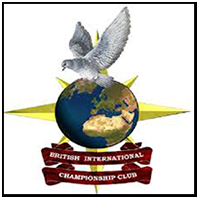PETER WELLS
of Dunstable
by Keith Mott
As I stated in my previous article my good friend, Terry Haley, arranged a mini loft tour of Hertfordshire for me in August, with the view to doing some articles and the second loft we visited was the highly successful fancier, Peter Wells of Dunstable. The Wells loft has had some great seasons for many years racing in the Combine, Classic and National. Peter has been a fantastic pigeon racer since he started up in the sport in 1974, but is mostly noted for being the owner and racer of one of the greatest sprint pigeons in the world of pigeon racing ever, Champion ‘Super Lou’. This wonderful Joseph Van Ramadonk widowhood cock was bred by Louella Pigeon World at Leicester and Peter purchased him in a batch of pigeons, which were eight for £80, so ‘Super Lou’ cost him £10. This champion blue chequer pied cock won 52 first prizes, including 16 times 1st Federation, 1st open Combine and several Open races. Peter told me, he has clocked ‘Super Lou’ and then had a batch of five come together five minutes later and taken the first six in the Federation result, that how good that pigeon was! He was always paired to ‘Brandy’ and she was another one from the Joseph Van Ramadonk job lot, and she was also another brilliant racer, winning several premier races. Champion ‘Super Lou’ was sold back to Louella for £11,500!
Peter Wells has enjoyed a great 2013 season, winning several first and 1st,2nd, 4th, 6th section, 2nd,3rd,6th, 9th open BBC Carentan (2,617 birds), 2nd, 4th, 7th section E, 47th, 68th, 94th open NFC Carentan, 2nd, 4th, 5th, 6th section, 11th, 28th, 30th, 32nd open L&SECC Messac, 15th section E, 19th open NFC Messac, 5th, 6th section, 13th, 14th open BBC Messac, 1st, 2nd, 3rd, 4th, 5th, 6th, 7th, 8th, 9th, 10th, 11th Spelthorne Open Yeovil 112 miles (617 birds). A great season!
Peter has a very smart 100ft ‘L’ shaped loft, which consist of three widowhood sections, two young bird sections and a stock section, with a wire flight so the inmates can get out into the weather. He has had his pigeons on deep litter for all his 40 years in the sport and thinks it’s brilliant, as it creates a dry atmosphere in the loft. The racing loft has double glazed frosted windows and doors, ETS trapping off landing boards and roof is made of Perspex for light and warmth. The stock loft is closed in with louvered windows for ventilation and this loft houses the widowhood hens during the racing season. Peter races 50 cocks on widowhood and 20 hens on the roundabout system and these are paired up in mid-February. The hens never see the cocks and some of the racers are flown dry, and never rear youngsters before racing, but are allowed to rear a late bred once racing has finished. Peter feeds a good quality widowhood mixture and breaks down in the early part of the week. The hens are only shown to the racing cocks on marking night in the early part of the season and never for the channel events, and Peter tells me he likes all racing from 80 through to 550 miles. One of Peter’s best birds at this time is the yearling blue cock, ‘Marieke Vink’, bred by his good friend Simon Schofield and winner of: 1st section, 2nd open BBC Carentan, 15th section, 19th open NFC Messac, 12th section, 22nd open BBC Messac.
The main family raced are basically Janssen and Peter tells me his loft houses several variations of the family, and have been very successful for him at all distances. The stock birds are fed on a standard ‘breeding’ mixture and he tells me his best stock bird is his Janssen hen number ‘11’. He keeps 15 pairs of stock birds and these are paired up the same time as the race team in February so a few eggs off premier breeders can be floated. Peter says, he pairs up quite late compared to most fanciers, but hates breeding in cold weather. Most of his best success has come from sprint / middle distance racing, although he has clocked a couple time on the day from Pau and Tarbes (560 miles). These days when he is looking to bring in new stock birds he is looking for quality long distance bloodlines. Good performance is the key when selecting new stock birds. He breeds about 80 young birds to race every season and they are put on the darkness system. Peter says, his darkness system isn’t very good, as he forgets and the youngsters sometimes get a lay in! The youngsters get lots of training through to 50 miles and Peter enjoys racing them through the whole programme. They race to the perch and are fed a standard young bird mixture and he maintains young birds have to race to get an education, and experience the English Channel in the first year. Peter told me he likes late breds, as training them after the racing season has finishes, gives him something to do and he has produced a few good racers from his late breds over the years. The birds are not parted in the winter months and for the moult they are fed a good resting mixture with oils on it. Peter is a heavy barley feeder in the winter months.
Peter’s entry in to the sport of pigeon racing was very similar to so many other fanciers I have met, with his relation picking up a pigeon with a broken leg in a local quarry and being fascinated with the bird, Peter volunteered to nursed it back to health. He had always liked pigeons and on contacting the owner, he didn’t want the bird back. The pigeon was housed in an empty chicken shed in Peter’s back garden and he obtained a John Gore hen to mate to it, and that was the start of him becoming a pigeon fancier. Those first birds bred and the following season Peter won one of the premier races, the Inter Counties Open, with a yearling, which was a brilliant achievement in his first full season racing. Peter told me the fancier who really helped him to start up was John McLaughlin of Dunstable and the top racer at that time was the late Derek Taylor of Leighton Buzzard who won the MNFC and L&SECC. His early pigeons were of the Dordin family and on establishing a small team of racers he joined the Dunstable SR Flying Club. Peter had caught the pigeon ‘bug’ and started as he has continued to do right through his 40 years in the sport, winning big races!
When I asked Peter how many times he had won the Combine he told me he had lost count, but had won it quite a few times and could remember that he had won 1st open Combine three times in one season. One of his best pigeons was the red pied hen, ‘The Cheetham Hen’ and she was bred by Frank Cheetham of Yorkshire. This wonderful hen was a true champion in every sense of the word, winning many firsts from Exmouth (150 miles) through to Bergerac (450 miles), including 1st Federation and Open Races. She also won two positions in the first hundred in the NFC Pau Grand National result and bred a 1st open Combine winner. What a pigeon! I first met Peter Wells in 1980 when he came to my home in Claygate to have his current 1st open Combine Bergerac winner photographed. He had enjoyed a brilliant 1980 season winning 29 firsts including six times 1st Federation and three times 1st Championship Club. He is a great Open Race specialist and in 1980 won 1st, 2nd, 3rd, 4th, 5th, 6th, 7th West Croydon Open Blandford and 1st, 2nd Stopsley Two Bird Open Dorchester. Brilliant pigeon racing, as in those days we used to use rubbers and clocks! In the 1980 season ‘The Cheetham Hen’ won 13th section E, 21st open NFC Pau Grand National (560 miles) with 5,894 birds competing and lifted £744. The Middle Counties Combine flew its longest old bird race from Bergerac in 1980 and the 1,960 birds were liberated at 05.30hrs in a light west wind. Peter Wells had two birds arrive at his loft together at 19.18hrs and he clocked them together to record: 1st Dunstable SR Flying Club, 1st Phoenix SR Flying Club, 1st, 2nd Federation, 1st, 2nd open Middle Counties Combine. Although Peter has won the Combine many times since, he rates this Bergerac performance one of his best! I can remember Peter’s Bergerac Combine winner was a handsome Kirkpatrick mealy cock called, ‘Super Sub’, and he had plenty of previous good form winning: 9th open Combine Niort, 1st club Guernsey and 1st Beds & Herts 3 Bird Championship Club Nantes. The winner of 2nd open Combine Bergerac that day was a red chequer hen bred by Bill Wells of Luton.

Peter likes to do his bit for our sport and is on the National Flying Club committee, President of the Mid-Shires Federation and is on the Federation committee, including forming the race programme ever season. When I asked him what he thought was his best performance to date his reply was, clocking on the day of liberation from the NFC Pau Grand National and winning 1st and 2nd Combine Bergerac in 1980 and clocking the only two birds in the Federation on the day. He has a great respect for the Corkett Family and says they are very dedicated, and work brilliantly as a team with their pigeons. Peter maintains the key to successful pigeon racing is dedication and hard work!
That’s it for this week! I hope my readers have enjoyed our feature on Peter Wells; he has been a very special fancier for the last 40 years! The third loft visit of our mini tour to appear shortly. I can be contacted on telephone number: 01372 463480 or my new email address: This email address is being protected from spambots. You need JavaScript enabled to view it.
TEXT & PHOTOS BY KEITH MOTT (www.keithmott.com)






















